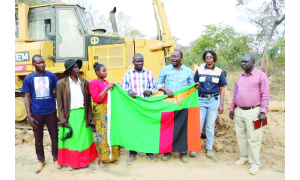
By JOWIT SALUSEKI-
ECONOMIC benefits of improved rural transport infrastructure stems largely from enhanced access to markets.
Improved roads reduce transport and input costs, increase timely input availability and consequently can result in higher agricultural productivity.
Simply put, investments in rural feeder roads is a cost effective way to help reduce widespread poverty in far flung areas of Zambia that for many years have been neglected.
This is premised on the fact that even in unfavourable settings where small scale farmers have low levels of marketed agricultural surplus, they face challenges in accessing markets because transporters shun areas where the road network is poor.
While the benefits of lower rural transport costs are well recognized, there is an increasing scepticism on returns to improve road investments especially so in rural areas due to low productivity and underuse of rural road infrastructure.
This then prevents rural communities from also enjoying some semblance of development in their localities.
Arising from the above scenario, Kalumbila Town Council has commenced works for the construction of Mwafwe Bridge and a 30 kilometres (km) stretch of road leading to the bridge in Matebo Ward in Kalumbila District.
The project was flagged off by area Member of Parliament (MP) Nicholas Mukumbi, Council Chairperson Shadrick Munjunga, the traditional leadership and other local administration officials.
The K2 million project has been awarded to the Zambia National Service (ZNS).
The works are being carried out using locally generated resources.
Speaking recently at the flag off ceremony, Mr Munjunga said Kalumbila residents will have easy access to Maheba area which previously belonged to Solwezi District.
The Maheba area is where services like health, education and a market are found.
“Now our residents will have access to the nearby settlement for various basic needs and services in Maheba and also the bridge will provide a shorter route connecting Maheba Refugee Settlement and Matebo Ward to other parts such as Kasempa,” Mr Munjunga said.
During the same ceremony, the Solwezi West MP thanked Government for approving the 2021 and 2022 Constituency Development Fund (CDF).
He said the finances have been well received in the constituency.
The MP also commended the Government for approving the 2022 council budget where the construction of Mwafwe Bridge and road works was submitted.
“What Government has done is commendable. They approved the 2022 council budget where funds for the bridge and road works leading to the bridge are reserved,” he said.
Kalumbila Town Council Director of Works Tenson Mfula said the local authority is elated that the 20km to 30km stretch of road is being done by the council.
He said the scope of works currently being done involve clearing and grading the gravel road.
Sub-Chief Shamaoma said he too was happy that development was being introduced in the area.
However, the traditional leader said Kalumbila District will need a market, a tower to improve communication and a permanent bridge connecting Kawizi and Mushingashi.
Among the projects that have been done by the council is the construction of a modern office block.
Aside from the home grown initiatives by the Kalumbila local authority, about US$200 million has been invested in building Kalumbila and making it a viable commercial destination.
This is according to an article published on the website www.miningforzambia.com.
The investment has been undertaken because when Sentinel Mine reaches the end of its working life in about 20 years time, it is intended that Kalumbila will not only survive, but thrive.
It is premised on the fact that mining activities have a short lifespan.
Although the area is still developing, the airport runway of the small town is already the country’s second longest.
It can easily handle mid-size regional jets.
When the runway eventually reaches its full design length of 4km, it will be the longest in the country.
This will make Kalumbila District to eventually become a major business and tourism hub.
Airlines from Angola, South Africa and other countries will be able to fly straight into the region to transport passengers and cargo, or simply to refuel.
Kalumbila intends to rival the established Copperbelt town of Kitwe in size and scope by 2050.
Several companies have already moved operations to Kalumbila’s industrial zone, attracted by its planned tax incentives, its infrastructure and growth potential, as well as the proximity of the Democractir Republic of Congo (DRC) and Angola as export markets.
To stimulate home ownership by residents, an innovative rent-to-buy scheme allows a portion of the rent to go towards buying the house; after 14 years, ownership is transferred.
To encourage private investment and land acquisition, Kalumbila is owned by the Kalumbila Town Development Corporation, not the mine.
It is envisaged that Kalumbila will eventually be classified as an independent town within the larger district, with autonomy to run its own affairs and ensure revenue raised locally is spent locally.
The viability of Kalumbila is a major reason why highly skilled mining personnel from the Copperbelt and abroad relocates families to this remote corner of Zambia.
However, the measure of Kalumbila’s success is not what it looks like now, but what it will look like in 20 years when the mining activities take a different shape.
By then, Kalumbila District will need to be big and diversified enough to stand on its own feet and be counted in terms of economic development.






